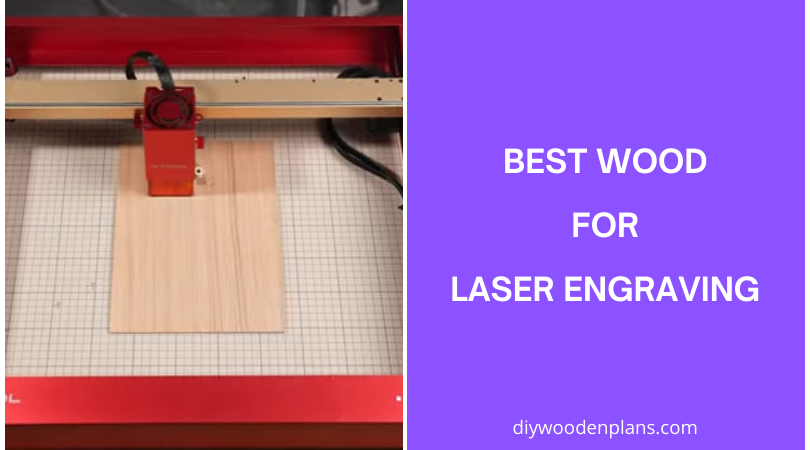YOUR NO 1 WOODWORKING POWER TOOLS RESOURCE WEBSITE
Selecting The Best Wood For Laser Engraving and Cutting (A Beginner’s Guide)

Disclosure: If you click on some of the links, we may earn a small referral fee. Please know that we only recommend products that we use and believe will add value to our readers.
As you dive into the world of laser engraving, you might be overwhelmed by the plethora of wood options available. You want your creations to shine, but the disappointing results of burnt edges or uneven engravings may be all too familiar.
This comprehensive guide aims to arm you with the knowledge to select the best wood for laser engraving, ensuring your projects come out with impeccable quality. We’ll explore how different wood characteristics affect the final product and give you solutions that turn those crafting frustrations into a blueprint for success.
In the meantime, check out our large list of creative xTool Laser Engraver Project Ideas.
The Science Behind Wood and Laser Interaction
The fusion of laser technology with traditional woodcraft is akin to an artist discovering a whole new spectrum of colors. With laser engraving, a powerful and focused beam of light is manipulated to etch designs into the wood’s surface. This machine-guided beam vaporizes the wood where it touches, creating precise, permanent markings with the potential for incredible detail and complexity.
However, the complexity doesn’t end with the technology. The chosen canvas – in this case, the type of wood – plays an integral role in the outcome of the engraving. Not all woods are created equal when they fall under the laser’s intense gaze. The interaction between the laser and wood is influenced by various characteristics intrinsic to the wood itself.
Characteristics of Laser-Friendly Wood
Five critical characteristics must be keenly assessed to ensure the success and quality of your engraving endeavors
Resin Content’s Impact on Engraving
The inherent resin content varies across wood types and directly influences the depth and darkness of your engravings. Woods with lower resin levels yield sharper and lighter engravings, ideal for more delicate designs that require finesse. Conversely, woods with a higher resin composition offer a darker cut, injecting a sense of boldness into your creations. Striking a balance based on the intended visual outcome of your project is crucial.
Importance of Wood Grain Patterns
Wood grain patterns, while aesthetically pleasing, can be double-edged swords in the realm of laser engraving. Dense or erratic grain patterns can cloud the intricacy of your engravings, causing the intended detail to be lost amidst the wood’s natural textures. Opting for wood with a, subtle grain affords a clearer canvas, ensuring that your laser-engraved designs remain sharp and uncompromised.
Moisture Levels and Cutting Efficiency
Moisture is your unspoken ally in the fight against unwanted char and burn marks that can surface during laser cutting. Pre-cutting treatment with moisture can help prevent these unsightly blemishes by balancing the wood’s temperature during the laser interaction. However, exercise caution; excessive moisture can lead to inconsistency, while insufficient levels invite burns, so moderation is key.
Color and Contrast (Wood Tone)
Light-hued woods stand out as the canvases of choice for high-contrast engravings, offering a pristine background that highlights the laser’s touch. Dark wood tones, while rich and attractive on their own, can diminish the visibility of your design and are generally more suitable for projects that focus on cutting rather than intricate engraving.
Density and Hardness Considerations
The wood’s density and hardness directly dictate the amount of laser power required to achieve your desired results. Softer, less dense woods are often easier to engrave with less power, while hardwoods mandate a more robust laser setting or multiple passes. Choose the wood’s hardness with your project’s design complexity and your laser’s capabilities in mind.
Say Hello to the Ultimate Craft Machine.
The xTool M1 Ultra combines laser engraving, cutting, inkjet printing, and blade cutting into one machine. Make crafting easier and better!
Most Popular Woods for Laser Engraving

It’s important to familiarize yourself with the most suitable and popular wood types for your projects. Each type of wood possesses unique properties that can greatly influence the outcome of your engravings.
The Engraver’s Choice Alder is a softwood highly favored for laser engraving due to its light tan to reddish-brown color, which deepens and reddens as it ages – giving a visually pleasing backdrop for designs. Its real allure lies in its ability to deliver high-contrast engravings; when hit by the laser, it offers a dark burn that makes your designs stand out distinctively. With a fine and even texture, and the presence of occasional knots, alder provides a character-filled canvas while maintaining consistency in results.
The Softwood Advantage Basswood is celebrated for its light and fine grain, making it another excellent candidate for laser engraving. The fact that basswood is a relatively soft wood works majorly to your advantage, allowing the laser to etch with lower power and yielding smoother, cleaner cuts. The uniformity in its grain lends itself to more etching, which is a boon when it comes to projects that call for subtlety and precision.
For deep, rich engravings Cherry’s warm, rich hues, combined with generally straight grain and fine, uniform texture, make it a prized choice for those looking to add a touch of elegance to their work. Its high resin content makes it a popular option despite its tendency for streaking. With time, cherry wood darkens, enhancing the depth and allure of the laser-engraved areas even more.
The detailer’s dream Maple boasts a light color and a tight, uniform grain which is excellent for detailed work. It’s a hardwood with a reputation for strength and the ability to take on stains well, accentuating your engravings post-process. While it may be a bit more challenging to work with than softwoods, maple’s ability to produce a dark contrast against its light background makes it a premium choice, particularly for engraving photographs with fine details.
Engineered for consistency Plywood is a versatile and economical choice. High-quality plywood is often made from layers of birch veneer. Their adhesive layers provide a uniform engraving surface, reducing the occurrence of burns and maximizing the laser’s performance. It’s an especially good pick for novice users due to its predictability and ease of use.
Woods to Approach With Caution

These woods should be approached with caution when laser cutting or engraving.
Woods like teak and cocobolo are densely packed with natural oils, causing more smoke and potential stains around the engravings. The oil makes the cutting less clean thus requiring a thorough post-process cleaning to bring out the beauty of the final piece. If you select these woods, a strong exhaust system is recommended to manage the smoke and any potential flames.
Softwoods, such as pine or cedar, are known for their high resin content. The resiny sap can result in a sticky, tar-like substance when heated by the laser, which can lead to uneven cuts and excessive char. A lower laser power and faster cutting speed may mitigate this, but be prepared for extra cleanup or sanding after the engraving process.
MDF (Medium Density Fiberboard)
MDF is popular due to its affordability and uniform surface. However, they are often bound together with formaldehyde-based glues, which when cut, can release harmful fumes that are unsafe to inhale and bad for the environment. Adequate ventilation and safety measures should be in place when working with MDF.
These coniferous woods generally have a more unpredictable grain pattern and a mix of harder and softer wood fibers. This can affect the consistency of your laser engravings and may require more fine-tuning of your laser settings to avoid a patchy appearance.
Prepping Your Lumber for the Best Laser Engraving Results
Before the beam of your laser even graces the surface of your chosen wood, you’ll want to ensure the canvas you’re working on is pristine for an optimal engraving outcome.
The Sanding Step
Sanding is the initial and pivotal step in the preparation process. Embrace the grain and begin with a coarse-grit sandpaper, advancing gradually to finer grits to achieve a smooth surface. This paves the way for the laser to interact flawlessly with the wood, preventing any uneven etching that imperfections may cause.
Cleaning Wood
After sanding, you enter the cleaning phase – where every particle of dust and residue should be removed. Use a soft, lint-free cloth and gently wipe down the wood. The absence of debris ensures every engraving pass is sharp and nothing short of pristine.
Considering sealants is akin to contemplating the finishing touch on a masterpiece. Applying a sealant can enhance the contrast of your engraving, but tread lightly – not all sealants are engraving-friendly. Opt for a thin, even coat of a laser-compatible sealant, if at all, as it wards off burn stains and can often aid in achieving more vibrant engravings.
Say Hello to the Ultimate Craft Machine.
The xTool M1 Ultra combines laser engraving, cutting, inkjet printing, and blade cutting into one machine. Make crafting easier and better!
Frequently Asked Questions (FAQs)
What are the best types of wood for laser cutting?
The best types of wood for laser cutting are generally lighter woods like basswood, balsa, pine, and alder. These types render clearer engravings and are easier to work with due to their consistent grain and adequate resin content.
How can I prevent burning or charring when laser cutting wood?
To prevent burning or charring, try adjusting the laser speed and power settings, use masking tape to protect the wood surface, ensure proper ventilation, and keep the wood moist during the operation. Using a honeycomb bed can also reduce flashback burns.
How does wood thickness affect laser engraving?
Wood thickness affects how much power and speed are required for the laser to cut through or engrave the wood effectively. Thicker pieces may require slower passes and higher power, while thinner pieces need lower power to prevent burning.
What is the best wood for laser engraving if I want high contrast in my design?
Woods like maple, alder, and birch provide a lighter background that makes the engraved areas stand out more prominently.
Where can I find the woods recommended for laser engraving?
You can find woods suitable for laser engraving at most hardware stores, craft shops, or lumber yards. Additionally, specialty online stores like the xTools store offer premium plywood and other wood sheets tailored for laser engraving.
What Laser Engraver and Cutter do you recommend?
We recommend the xTool M1 Ultra (4-in-1 craft machine). It combines laser engraving, laser cutting, inkjet printing, and blade cutting into one powerful and versatile device. With enhanced precision, faster processing speeds, and support for over 1,000 materials, the M1 Ultra is an excellent choice for both beginners and experienced makers.
Related Articles:
Conclusion
Selecting the best wood for laser engraving boils down to understanding each wood’s unique properties—from resin content to grain pattern—and matching it with your project requirements. Popular choices like alder, basswood, cherry, maple, and plywood each offer distinct advantages for laser engraving, while preparation steps like sanding, cleaning, and sealing are crucial to achieving optimal results.
Just getting started with laser engraving? See our beginner’s guide to using a laser engraver for woodworking
Pinterest Image

Enjoy our articles? You can follow us on Pinterest for more woodworking power tools tips and tricks.
Save on selected power tools from top brands - Shop Now on Zoro.



